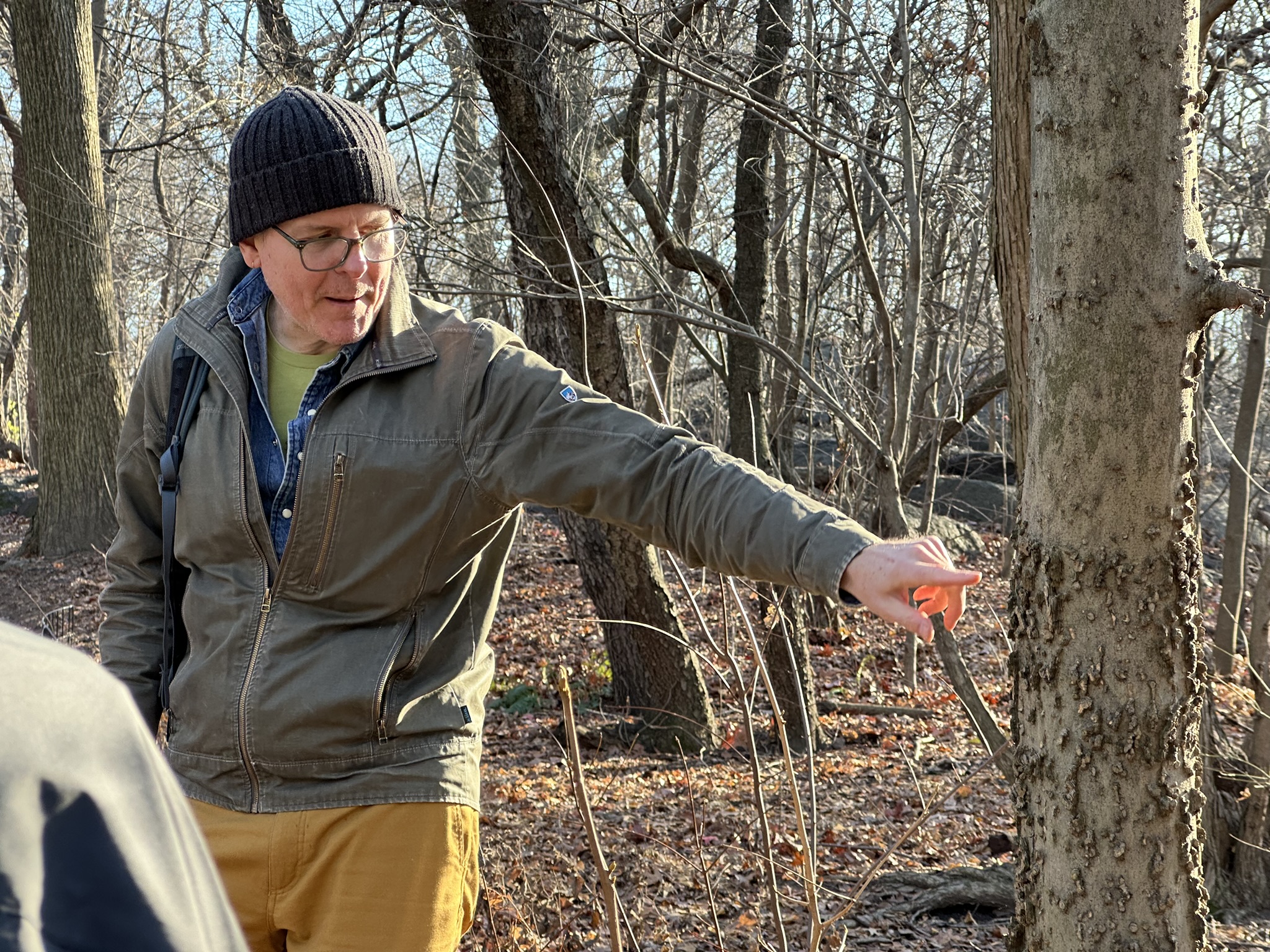
By Bonnie Eissner
The first day of winter conjures up notions of leafless, brown trees that can induce New Yorkers to start “California dreamin’,” as The Mamas & the Papas sang. But to Carey Russell, founder of The Dendro Lab, these less flashy winter neighbors offer the chance to observe new colors and wonders.
“We usually just think of these almost expressionistic, high-contrast, black-and-white silhouettes, these witchy-looking trees in a winter forest,” Russell said on a December Saturday in Central Park, “but if you get in a little closer, you’re like, ‘Oh my gosh, there’s these Winnie the Pooh yellow bitternut hickory buds, and there’s all sorts of interesting things going on.’”
Russell, a dendrologist, or naturalist who specializes in trees, was leading eight people on a winter tree identification walk in the Ramble as part of his Dendro Lab project. Through a series of 12 walks, he teaches people to identify the 100 most common tree species in the mid-Atlantic region.
Russell uses trees, he says, as portals through which people can connect more deeply with nature. The concept is similar to birding. By appreciating birds, even vying to identify species, birders commune with nature and with each other. He even created a tree species checklist akin to the species lists that birders use to record their sightings, and people who complete his dozen tree walks receive a badge. Several of the walkers on Saturday were repeat customers, showing that the concept is catching on.
Russell leads most of the walks in the spring and summer when deciduous trees have their foliage and are easier to recognize and enjoy. But in winter, trees reveal other features, such as buds, berries, and bark, that are obscured in the leafy seasons. More subtle than leaves, these characteristics offer alternative ways to differentiate trees and savor their complexity.
During the two-hour walk in Central Park’s forest-like Ramble, where trees and plants are gardened with a lighter touch, Russell pointed out and invited participants to explore the ways trees display their diversity in winter.
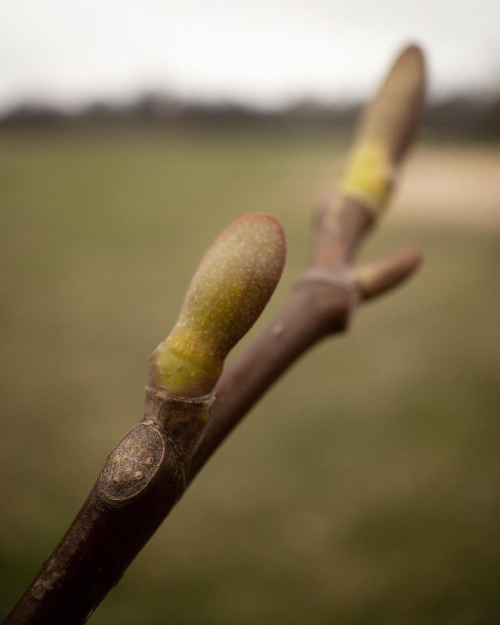
Buds
When leaves are gone, for example, leaf buds become more apparent. Distinct from one another, they offer a quiet beauty. Buds vary by shape, texture, size, placement, and color. The olive green, peanut-shaped bud of a tuliptree differs from the scaly, rusty red, spear-shaped bud of a northern red oak tree.
In the Ramble’s aptly named tupelo meadow, Russell invited participants to use the hand lenses he distributed to observe the buds on the tips and sides of the tree branches. He urged the group to describe the buds precisely. “Use J. Crew colors,” he said, as people called out the hue, starting with red, then maroon, and, finally, wine. “I love it,” Carey said. “There is like a burgundy red, right? That’s what I want to hear. You will never see a bud have quite that burgundy red color other than the buds of black tupelos.”
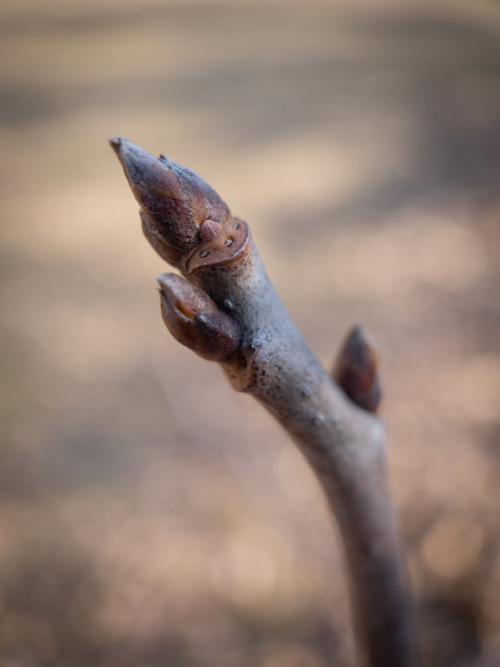
Trunks, Bark, and Branches
Trunk and branch shapes, colors, and patterns can offer telltale clues for some tree species. Near a cluster of towering American elms, Russell, a professional filmmaker and photographer, described their shape in cinematic terms. “It’s like a fountain,” he said, “or the stem of a wineglass at the base and then the emergence of all these multiple lateral branches halfway up.”
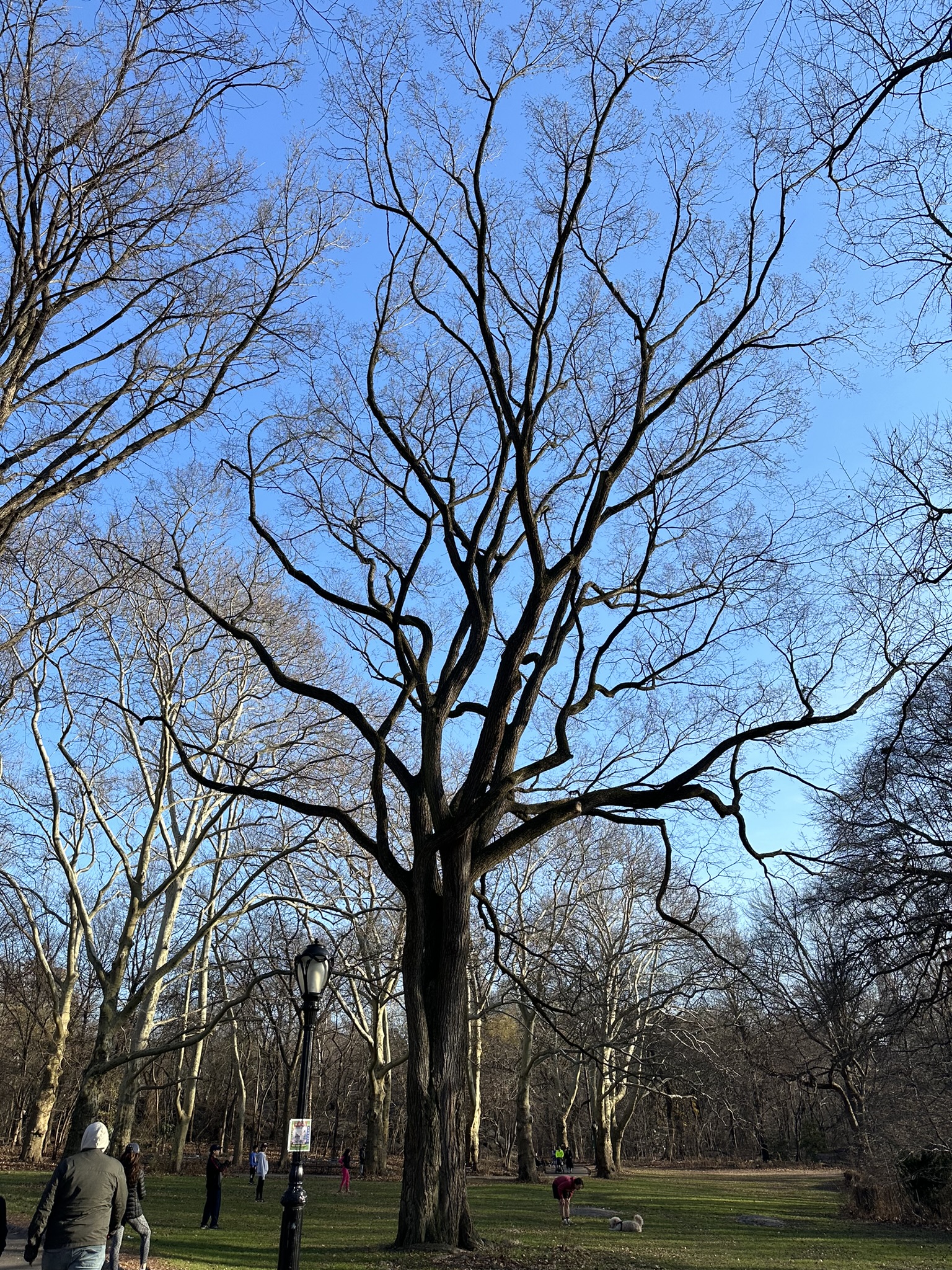
Just beyond the elms stood equally tall plane, or sycamore trees. Their bark is easy to recognize. At the base, it’s mottled and olive green, Russell pointed out. But near the top, it turns bone white.
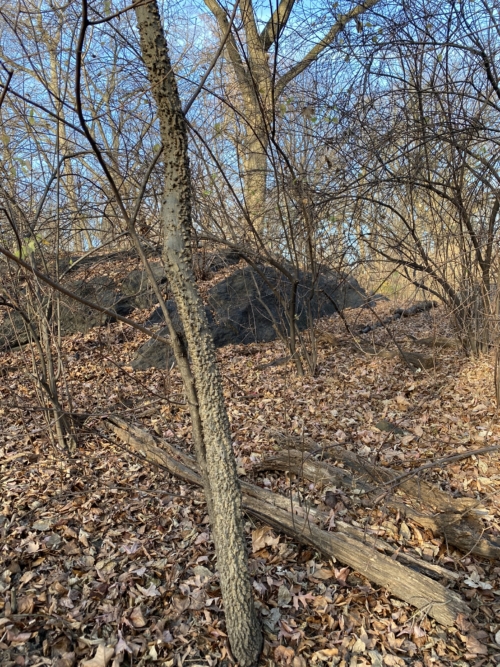
Hackberry tree bark is also distinct, Russell showed. Overall, it’s smooth and grayish, similar to beech tree bark, but hackberry bark is interrupted in places by patches of wart-like shapes.
A straight, or excurrent, shape in a broadleaf tree is another giveaway. Most broadleaf trees have a rounded, or decurrent, shape familiar in elms, maples, and oaks, Russell said. But two local trees – the tuliptree and the sweetgum tree – grow straight up.
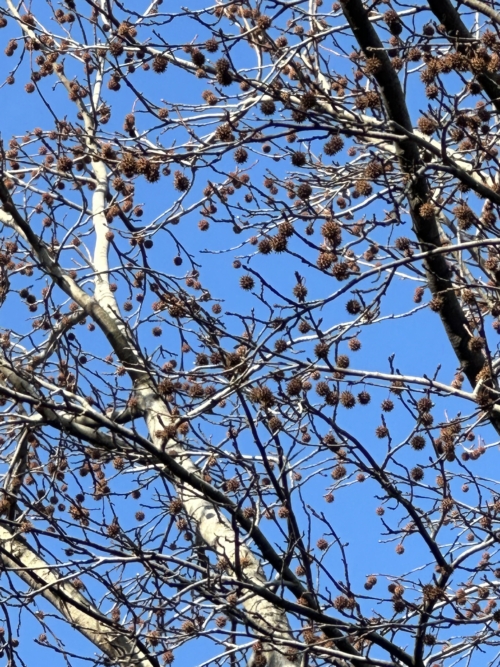
And the sweetgum has a second telltale characteristic: sweetgum balls. The woody, spiky balls carry the trees’ seeds. While many fall to the ground, wreaking havoc on suburban lawns and lawnmowers, others cling to branches throughout the winter, dangling like ornaments on a Christmas tree.
The string-bean-shaped seedpods of the northern catalpa also stick around through late fall and winter. Green in the summer, they turn dark brown in autumn and hang from the tree’s branches like drop earrings.
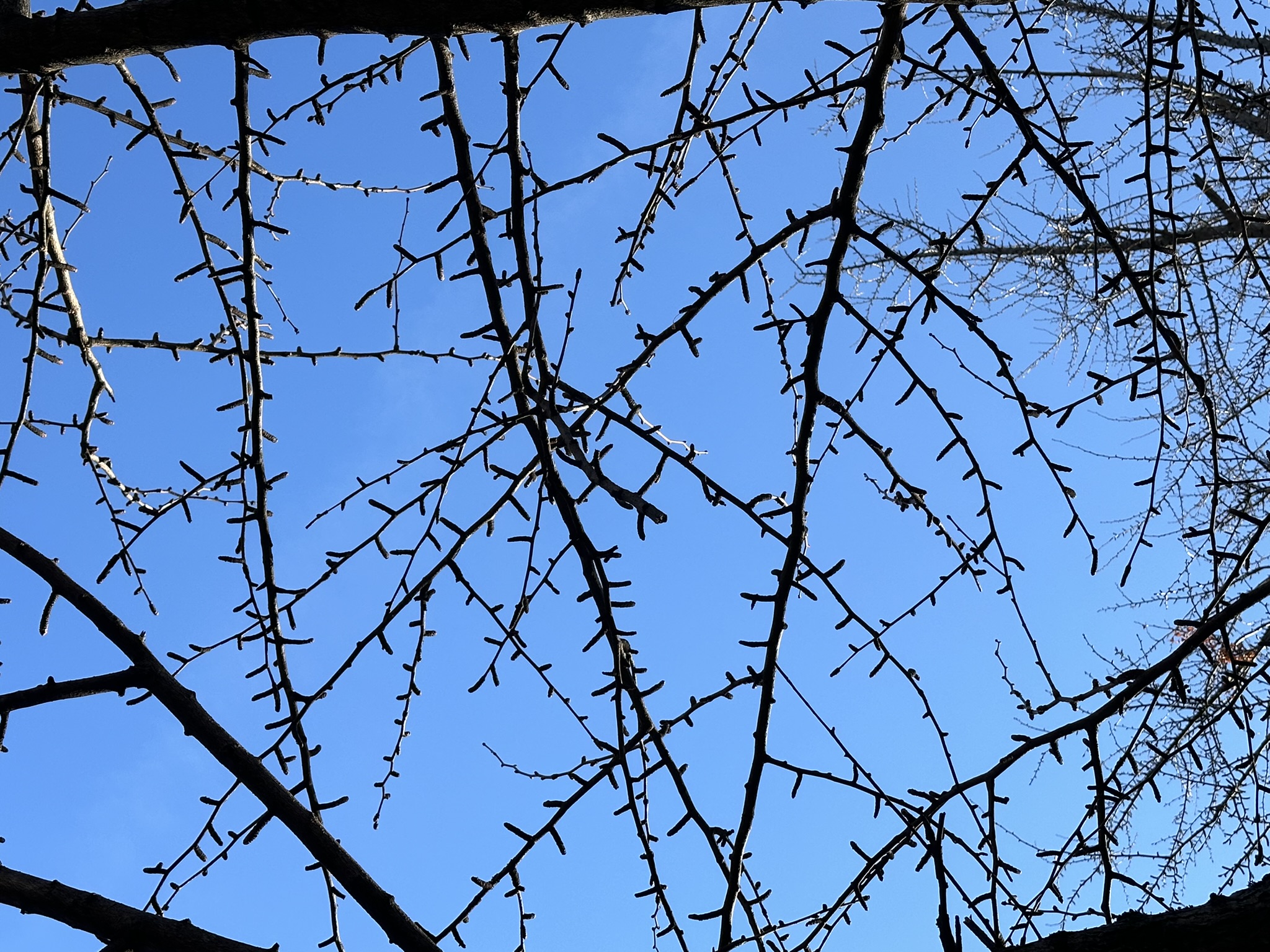
Defenses
To survive long enough to reproduce, trees have developed innovative defense mechanisms through the millennia. Younger oak and beech trees retain their shriveled brown leaves into the late fall and early winter to deter browsers, past and present, from nibbling on their branches. These munchers include the white-tailed deer of today and the giant sloths and mastodons of the Pleistocene epoch.
Other local trees, like the honey locust, arm themselves with thorns. Not to be confused with the so-called thorns of a rosebush, which, botanically speaking, are prickles that derive from the plant’s skin tissue, tree thorns are made from stems and are modified twigs. Russell pointed out the fearsome thorns of a honey locust tree. A thornless variety of the tree, aptly called the thornless honey locust, is a prevalent New York City street tree.
Russell concluded the walk with a call to action.
“Too many of us walk in nature completely oblivious to what’s going on,” he said. “And you’re no longer allowed to do that. If you look at it on a different scale, there’s all sorts of beautiful, fascinating and colorful things going on that would have eluded you,” he added.
William Papp was attending his fourth Dendro Lab walk on Saturday. He started the walks, he said, because he enjoys birding. When fellow birders spot birds, they often name the types of trees that they’re in. Without that knowledge, it can be harder to sight birds. But, beyond birding, the tree walks have given him a new appreciation for the park that he considers his backyard, he said. “It’s really fun to learn the language of the different trees,” he concluded, “and you walk through this park in a totally different way.”
Subscribe to WSR’s free email newsletter here.










This piece inspired me to visit the Ramble today. Thanks!
Delightful tale of trees. Who knew? Ill be looking in a totally new way on my park walks. Wonderful descriptions and photos.
Love the headline. Been singing the song all day…Despite it being Thursday!
This beautifully written and photographed essay goes so much deeper than the descriptions I learned from the Boy Scout Handbook. That was was like the primer for grade school. This is what I would have loved to learn way back then. I’ll be visiting the Ramble as well as the North Woods with a new eye and appreciation. Thank you for posting.
Inspiring essay.! Thank you.
I’ve been volunteering in Riverside Park and the Broadway Malls for 30+ years, and am also a Citizen Pruner with Trees NY. Once I began learning about the trees in NYC, and other shrubs and plants, I was hooked. I have some beautiful old tees in the area of Riverside Park I work; lindens, London planes, gingkoes, hawthorns, others. I track them in the summer and winter for health, growth, branching, pruning needs, etc., and it keeps me occupied and is never boring. I also keep track of the street trees in my neighborhood, and if there is something I need to do, try to take care of it. We have a great “urban forest” here, and folks are encouraged to help to protect and care for it!
There are all sorts of interesting things going on…
A week ago, I first noticed branches ( on an otherwise bare tree) in full bloom with fresh small pink flowers. It was (and still is) located near the bottom of the hill as you enter Riverside Park at 91st street. I cannot explain this.. It is December!!